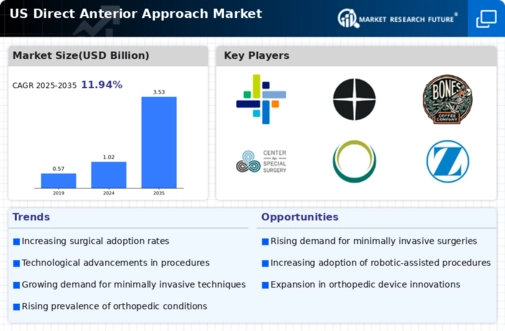Market Share
U.S. Direct Anterior Approach Market Share Analysis
The market dynamics of the US Direct Anterior Approach (DAA) unfold within the orthopedic landscape, influenced by factors ranging from patient preferences to surgical advancements and healthcare trends. The Direct Anterior Approach is a minimally invasive surgical technique for hip replacement that involves accessing the hip joint from the front of the body. One key driver of the market is the increasing popularity of the Direct Anterior Approach among patients and surgeons alike. This approach offers potential benefits, including faster recovery times, reduced pain, and minimal muscle damage compared to traditional hip replacement methods. As awareness grows among healthcare professionals and patients about the advantages of DAA, the demand for this technique rises, shaping the market dynamics significantly.
Technological innovation plays a pivotal role in shaping the market dynamics of the US Direct Anterior Approach. Advances in surgical instruments, imaging technologies, and navigation systems have contributed to the refinement and widespread adoption of the DAA. Real-time imaging and computer-assisted navigation assist surgeons in precisely positioning implants and optimizing outcomes, enhancing the overall efficiency and success of hip replacement surgeries. The continuous evolution of technology not only improves surgical precision but also contributes to expanding the applicability of the Direct Anterior Approach to a broader patient population.
The collaborative efforts within the orthopedic community, including partnerships between medical institutions, orthopedic surgeons, and device manufacturers, contribute to the dynamic landscape of the US Direct Anterior Approach market. These alliances foster knowledge exchange, facilitate training programs for surgeons, and drive research initiatives aimed at refining surgical techniques and optimizing patient outcomes. The synergy between different stakeholders accelerates the integration of the Direct Anterior Approach into orthopedic practices, leading to a more widespread adoption of this minimally invasive technique.
The engagement of orthopedic device manufacturers in the development of specialized instruments and implants tailored for the Direct Anterior Approach is a significant factor shaping market dynamics. Companies specializing in orthopedic implants invest in research and development to create products that are compatible with the unique requirements of DAA procedures. This includes innovative instrumentation designed to facilitate the surgical technique and implants that provide optimal stability and longevity. The ongoing pursuit of improved devices reflects a commitment to enhancing patient care and addressing the evolving needs of orthopedic surgeons utilizing the Direct Anterior Approach.
Regulatory frameworks and standards also play a critical role in guiding the market dynamics of the US Direct Anterior Approach. Adherence to regulatory requirements ensures the safety and efficacy of surgical instruments, implants, and technologies used in DAA procedures. Regulatory oversight provides a framework for the development and approval of new devices, ensuring that they meet rigorous standards and contribute to improved patient outcomes.
Economic factors, including healthcare spending and reimbursement policies, contribute to the market dynamics of the US Direct Anterior Approach. The economic feasibility of DAA procedures and the availability of reimbursement options influence their accessibility and adoption within healthcare systems. As stakeholders seek cost-effective solutions that align with budgetary constraints, the market responds by striving to deliver value-based care through the Direct Anterior Approach, emphasizing improved patient outcomes and reduced overall healthcare costs.










Leave a Comment